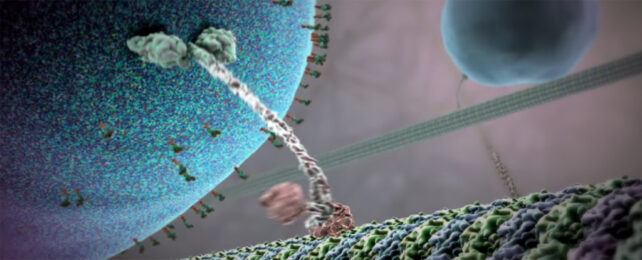A gif of a protein molecule 'walking' along a filament while carrying a large sphere on its shoulders is one of the internet's most widely shared 'science' posts.
Trending online since at least 2014, the cute animation continues to receive a great deal of attention whenever it is shared again. Several posters have speculated that it's a visual representation of happiness itself – in short, myosin transporting endorphins in the brain.
It's fascinating and heartwarming to watch that tiny creature exert such effort to bring joy, but is there scientific merit to the claims that it portrays happiness? The short answer is no. But just like cat videos, it sure has made many people on the internet happy, and that's something to smile about.
The original video's lead creator, medical artist, and animator John Liebler explained the real story in 2014, and we think it's a fun story in itself, not that the internet has changed its tune much in the nine years since.
@monicapina04 AMAZING! #cells #innerlife #happiness #lookslike #facts #fact #fyi #fyp #brain #research #facts #animation #myosin #interesting #education #viral #fypシ #humanbrain #mentalhealth #science #stem
A recent TikTok post demonstrates the most widely held interpretation – that it represents a myosin molecule transporting endorphins. Endorphins are naturally occurring peptides in the brain that act to dull pain perception and heighten feelings of contentment.
One amusing trend has YouTube accounts sharing the gif with upbeat music that's enough to get the endorphins flowing for many of us. Twitter, imgur, tumblr, and reddit users shared multiple versions of the same idea, and even Wim Hof, a Dutch motivational speaker and so-called iceman, shared it on Facebook.
Liebler and the team at XVIVO created the 3D computer animation in 2006 for a biology classroom video called "The Inner Life of the Cell" in collaboration with two Harvard University researchers, Robert Lue and Alain Viel.
The key point here is that the educational video wasn't intended to depict a brain process at all; instead, the video is designed to take the viewer "on a journey through the microscopic world of a cell, illustrating mechanisms that allow a white blood cell to sense its surroundings and respond to an external stimulus."

The viral gif is based on one part of the video, starting at about 1:14, which actually shows a kinesin protein 'dragging' a pouch called a vesicle along a microtubule. Kinesins are motor proteins that lug various cargo about, and microtubules are the internal structural supports of our cells.
"The kinesin motor protein was a real scene stealer in Inner Life, although it wasn't even in the original treatment for the short," Liebler wrote in 2014.
"The original plan was to omit the motor protein in the vesicle shots, but when I saw Graham Johnson's animation of the way a kinesin takes a step…"
"There have been some 'creative' interpretations attached to this image," Liebler went on to explain. "But what is pictured here is a kinesin motor protein pulling a vesicle along a microtubule. The vesicle could contain neurotransmitters like endorphins, or it could be carrying some other cargo."
The hugely popular video certainly does a beautiful job of showing how cell transport works in general terms, and that's important for education. It's no less cool that it's showing a kinesin protein marching along a microtubule in a white blood cell and not a myosin protein in a neuron.
"The motions of muscles, as well as much smaller intracellular cargoes, are driven by molecular motors that move unidirectionally along protein polymers (actin or microtubules)," researchers wrote in a 2000 paper for Science.
"The opportunity to study and compare numerous kinesin and myosin motors provides a valuable resource for understanding the mechanism of motility."
So apparently this is NOT happiness, which makes me sad. It seems to be a protein cell, just not myosin. No more joy tonight!
— Rabih Alameddine (@rabihalameddine) February 13, 2016
In the brain, kinesins are involved in the transport of neurotransmitters and other chemicals within neurons. But in any cell, kinesins are the packhorses of proteins, doing much the same job with different cargo packaged up into bulging vesicles.
Researchers have found a kinesin protein's 'strutting' step is about 8 nanometers long, while a myosin protein's 'stiff-legged' steps are 74 nanometers in length and were captured by scientists in 2015. They created a video to demonstrate.
That aside, happiness is slightly more complicated than myosin delivering endorphins to our brains. Dopamine plays a part, along with other neurotransmitters like serotonin, norepinephrine, and endorphins, and more broadly, biological health and genetics.
While it may not be the visual depiction of happiness, if the gif makes you happy, then by all means, share it so others can feel happy too. Just add a scientifically accurate caption if you can.
